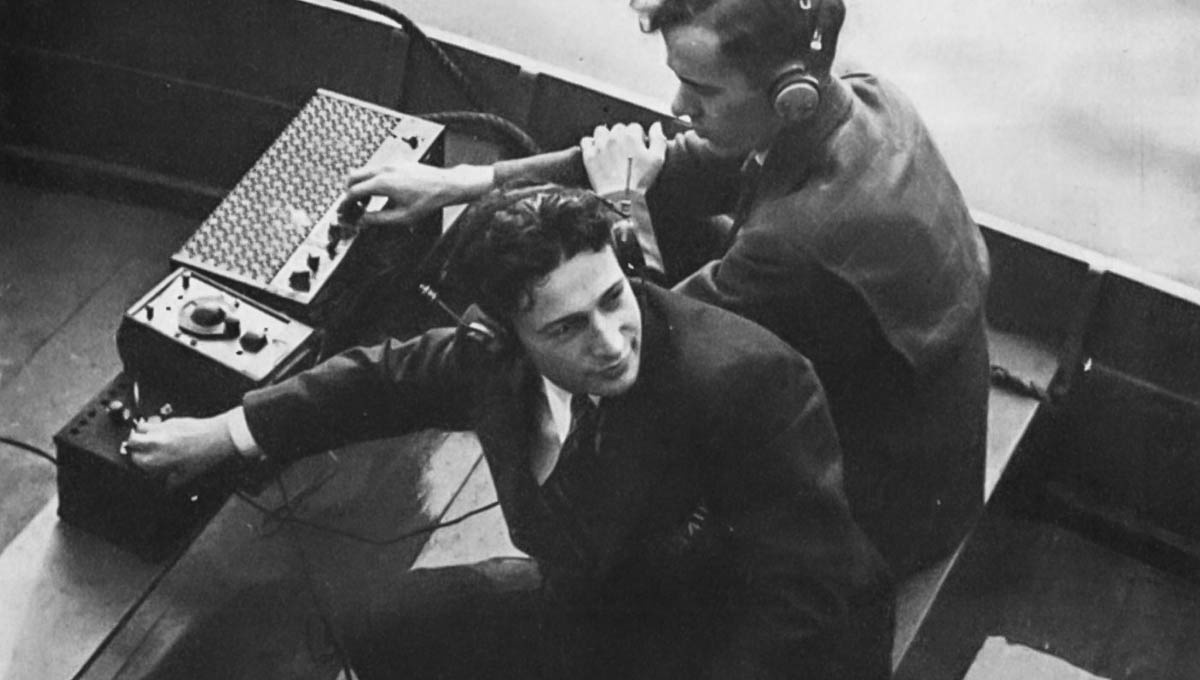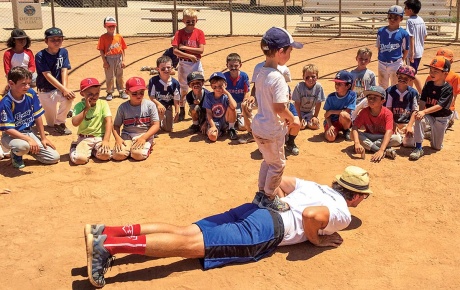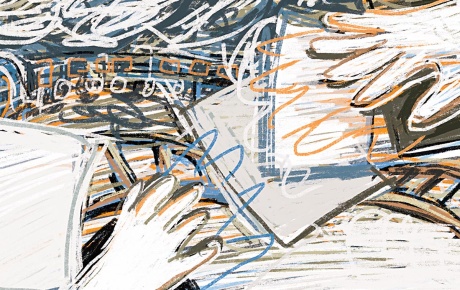From the Archives: Calling All Housing and Dormitories
BAM’s October 1981 article on the ‘Gas Pipe Networks’
All of the 1,000 or more college radio stations in operation today trace their roots to Brown, where in the late 1930s some enterprising students strung wires through the campus heating tunnels and founded the Brown Network. That humble beginning, and the eventful years of expansion that followed, are chronicled in The Gas Pipe Networks: A History of College Radio 1936–1946, written and published by Louis M. Bloch, Jr. ’40. Bloch, who was a participant in the first Brown Network and who served as business manager for the Intercollegiate Broadcasting System from 1940–46, believes his personal scrapbooks and photographs from that era form a unique record.
“I felt strongly that the story of one of the most important developments in radio had to be told,” Bloch says. A former rare-book dealer who now publishes primary source materials for schools, Bloch published The Gas Pipe Networks in 1980. The book has attracted wide attention in the communications community, receiving favorable reviews in Billboard, Choice, and several major daily newspapers, and getting Bloch on a number of radio and TV talk shows this past year.
The early campus radio technology Bloch describes—with students hooking up radio receivers to a nearby gas pipe, electric line, or other conductor to receive broadcasts—is a far cry from the present sophistication of college radio. WBRU, successor to the original Brown Network, for example, is a full-fledged commercial FM station with a powerful signal reaching much of southeastern New England. But, as Billboard’s reviewer suggested, today’s college broadcasters might not only “get a kick” out of Bloch’s book, they also might “find themselves drawing an idea or two from their predecessors.”
The excerpts from The Gas Pipe Networks on these pages are reprinted with the author’s permission. Photographs are from the collections of Bloch and David Borst ’40.

I had obtained my amateur radio license the year before, during my senior year at Cleveland Heights High School. Although radio was one of my interests and although I had constructed my receiver and transmitter, I never was an expert in electronics. I learned that George Abraham ’40 and David Borst ’40, both freshmen, had linked their rooms in Caswell and Littlefield Halls, two dormitories about a quarter of a mile apart, by wire and had set up an intercommunication system between them. It was at this point that I contacted them and was invited to participate in the Net. Dave Borst ran a line to my room in Hegeman Hall and connected it to my radio receiver. Also, he connected a microphone that I could use for intercommunication.
That small Net continued and very soon in the first semester of our freshman year we had many outlets all over the campus. Not only was I able to communicate with other participating freshmen, but soon George and Dave added a second line so that the Net could also operate as a broadcasting system. On special occasions programs were broadcast from the master control in George Abraham’s room. We had special music programs and occasional interviews. The most important “first” of college radio occurred at that time. Henry Merritt Wriston was to be inaugurated as president of the University, but the hall that was to be used on campus was too small to accommodate the students. George obtained permission to broadcast that event, and that broadcast turned out to be the first major broadcast of college radio. Our audience was large and interested.
At first the Brown broadcasting and communication systems consisted of wire lines connected to the radios of participating students on campus, and this complicated arrangement required a crew to string the lines, make the connections, and maintain the system. As more and more students became interested, lines were strung to all parts of the campus. Dave was in charge of everything involved in engineering and in the installation and maintenance of the lines and soon had a crew of forty students helping him. Truly this was a network of lines tying the campus together, and the press referred to our station as “The Brown Network.” It was difficult for the college administration to comprehend what was going on and they had only a vague idea of what George and Dave were up to. And so it was, back in my freshman year, that college radio got its start.
In those days it was the custom for the sophomores to form a vigilance committee, a self-appointed and unauthorized committee to keep the freshmen in their place. In past years this had been done by hazing, but in the year 1936 at Brown little did the sophomores know that the freshmen had their own communication system between most of the dormitories. They did know of our broadcasting to the campus but Line One, a line for communications, was reserved only for freshmen, and for some reason the sophomores involved in the vigilance committee never knew about Line One. As the vigilance committee moved from room to room and from building to building they were bombarded with water bombs, balloons filled with water thrown from the rooms of the freshmen, down the stairwells, and also from the roofs of the buildings. Their every movement about campus was reported and after that disaster the vigilance committee was never heard from again.
Our new president, Henry Wriston, while walking on campus, inquired as to what all of those students were doing on the roofs of the buildings. When he was informed that they were stringing and repairing lines for The Brown Network he dropped the subject and continued his walk without any further questions in that regard. The administration, it seems, had decided to tolerate us in the belief that this was just another type of student prank that would soon be forgotten. President Wriston did not see the seven lines running over the buildings tying the campus together and originating from George's room. He did not interfere with The Brown Network, nor did the college administration. When I became a member of Pi Lambda Phi fraternity in my sophomore year, I moved to another dormitory, Caswell Hall, with my new roommate Jerome Frank Strauss, Jr. '40, now a prominent doctor in Chicago. My radio was again attached to the network lines. More and more students became interested in being tied into The Brown Network, and George, in addition to broadcasting from his room, set up remote transmission points around the campus, including the Music Building. This opened up the vast classical music collection of the music department to us.
Through George's salesmanship The Brown Network became recognized as an extracurricular activity and we were granted a room in Faunce House. George, however, continued to maintain a broadcasting outlet in his room in Slater Hall. A formal organization was established and Dave and his engineering crew built a broadcasting studio with complete facilities, including soundproof studios and a central control room with thirty outlets in dormitories and fraternities where programs could originate. A new transmission system was developed using low power limited to two watts. Programs were carried over 30,000 feet of wire strung through steam tunnels and over the roofs of buildings into the dormitories and fraternity houses. The power was so small that broadcasts could only be heard within the buildings covered, but special receivers were not required and programs could be tuned in at 570 on the radio dial. Since the Network did not radiate beyond the buildings, the station needed no license. In some cases the transmitter was coupled into the heating system of the buildings, or the electric lighting system, or in other cases into small remote transmitters located in some of the buildings.

With the approval of The Brown Network as an established extracurricular activity, many campus organizations cooperated with us, including the glee club, the dramatic group, and the Brown Daily Herald, which featured our activities and programs on a regular basis.
In 1939 I became business manager, succeeding Peter Thorpe '41. With Pete's help we developed a brochure entitled "The Brown Network, America's First Collegiate Broadcasting System In One of New England's Key Cities." Rates were listed for Class A and Class B radio time. Class A being prime time, 8 p.m. to midnight and all day Sunday, and Class B including all other hours. Class A time rates were $50 per hour, $30 per half hour, and $18 per quarter hour with $3.50 charged for one-minute spots. Quantity discounts were allowed. Class B time rates were $30 per hour, $18 per half hour, and $11 per quarter hour. One-minute spots for Class B time were $2.50, all with quantity discounts.
Up to this point each of us had financed the station out of his own pocket. This was especially true of Dave and George, who had financed the original station. I was able to obtain a small amount of advertising from local merchants, but money was tight and collections difficult as we were at the end of the great depression. I had a major collection problem with a local men's store, but George solved the problem. He purchased a jacket at the store and notified the store owner that he had paid The Brown Network to cancel the debt. George was a great diplomat and succeeded in solving some of our most difficult problems in a most unusual way.
On November 3, 1939, a distinguished visitor addressed our chapel service on campus. David Sarnoff, president of the Radio Corporation of America, said in his address that over the years Brown had contributed greatly to the intellectual growth of the nation and had given the nation many great and distinguished leaders. He added that in the future Brown would also be remembered for another important contribution. The Brown Network — the pioneer campus radio station — which had now succeeded in developing an extracurricular activity, college radio, parallel to the college newspaper. He predicted that in the not-too-distant future college radio would be the greatest training ground for the radio industry. This prediction has come true to an extent even greater than he had predicted at that time. Today thousands of radio and television executives, sports and program announcers, and engineers trace their beginnings to college radio stations.
Edward Sarnoff '42, David's son, was a member of The Brown Network. After chapel President Wriston invited David Sarnoff to lunch. He accepted with the request that he be able first to visit the original Brown Network in George Abraham's room, where, after being introduced by his son, he would broadcast a greeting to the students. The Providence Journal of November 5, 1939, carried a picture of this famous broadcast with the caption "RCA Head Broadcasts over 'Rival' Network." President Wriston and the administration finally realized that this band of students, who were climbing over the roofs of Brown's ivy-covered buildings, going into the steam tunnels, and interviewing students and members of the faculty on campus, could contribute greatly to the accomplishments of this staid and conservative University.
After the visit of David Sarnoff, the press of not only Providence but of the entire nation became interested in The Brown Network. As undergraduates, we were in the limelight. The story of our new station was not only important to the future of radio but also was a story of great human interest.
On December 3, 1939, the Providence Journal in its Sunday edition featured The Brown Network in a full-page story showing various activities of the station. Photos included the control room at Faunce House, reporters in a boat broadcasting the progress of a dinghy race on the Seekonk River in Providence, a group of students at the Delta Upsilon fraternity house listening to a "network" program, a broadcast of a football game from the stadium, and a one-act drama thriller being broadcast with the aid of Pembroke students. Included in this photo was Helen M. Thomas '40, later to become Mrs. David Borst.
The Christian Science Monitor sent its radio reporter, Albert D. Hughes, to Brown and he reported as follows: "You might call this one of the first stories ever obtained by collegiate wired radio. George Abraham, Brown senior, stepped to a panel in his room in Slater Hall on College Hill here, threw a few switches, picked up a hand microphone, and in a friendly 'Calling All Cars' manner said, 'Abraham in Slater calling all houses and dormitories.' Back at him through an overhead loudspeaker came nearly a dozen voices—'Faunce Calling,' 'Metcalf Calling,' 'Hope Calling'—as the various dormitories answered him. 'Listen, fellows,' George retorted, 'I've got a reporter and a photographer here and we are coming around to take some pictures, so wait until we get there. We would like various groups of you to pose for them. Okay? Swell. We'll be seeing you.' In a few minutes' conversation, we had let a fair portion of the University 'in' on our mission there. Was ever a reporter's or photographer's work more easily cut out?"
As news of this new campus "fun station" spread, we began to receive cooperation and offers of help from the radio industry and the major networks. The Columbia Broadcasting System allowed a Brown commentator, sent to cover the Brown-Princeton football game at Princeton, to give his account to the students back home from the CBS booth. It allowed The Brown Network to connect its rented telephone line to the CBS booth.
In 1939, Pembroke College was added to The Brown Network by means of leased wire lines to miniature transmitters in Metcalf, West, and East Halls. Jean Bruce '40 was in charge of the thirty Pembroke women working on The Brown Network.
Other colleges, mostly in New England, contacted us requesting information regarding the construction of stations on their campuses. Dave, always helpful, sent detailed instructions and visited several of the campuses. The second station to commence operation was WES, the Cardinal Network at Wesleyan University at Middletown, Connecticut, which made its first broadcast on November 9, 1939, with a daily alarm clock wake-up program from 7:30 a.m. to 8:30 a.m. and the daily "Jive at Five" starting at 5 p.m. Soon other programs were added, including "The Argus Reporter," "The Symphony Hour," and on Saturday nights, "The Midnight Matinee." President McConaughy of Wesleyan gave official permission to the station to use the college heating tunnels to run wires to all buildings on campus.
The first convention of the Intercollegiate Broadcasting System was held at Brown on February 17 and 18, 1941. Invited as guest speakers were Dr. Franklin Dunham, educational director of NBC; Dr. Loring Andrews, chairman of the program committee of the World-Wide Broadcasting Foundation; H. Linus Travers, vice president of the Yankee Network; John Holman, general manager of WBZ, Boston; Malcolm Parker, supervisor of station WEAN, Providence; and James A. Williams, district manager of the New England Telephone Company. President Wriston welcomed the delegates. George Abraham placed the Brown athletic director—who once had pulled out the tubes of the radios in Faunce House during a football broadcast so the students would go to the game—between two important radio executives and directly across from the Brown Network board at the dinner. And the assistant dean, who had caused us no end of trouble, was placed in the midst of radio executives who, at the dinner, constantly praised college radio.
George Abraham was elected chairman of the Intercollegiate Broadcasting System, and assisting him were Peter Thorpe, advertising manager; David Borst, technical manager; and Joseph Parnicky '40, program manager. I was elected business manager and it was my job to obtain advertising for the college radio stations. All were volunteer jobs as IBS had no income of any kind. A constitution and by-laws were adopted. Once broadcasting systems were established at the other colleges, the IBS was to act as a medium through which programs and ideas were to be exchanged as well as an agency to obtain national advertising. No budget or any other monetary consideration was even discussed at this first convention. It was our conviction that things would work out somehow. We never had any money, so why worry about it. As I learned, personal sacrifices had to be made, but at that exciting moment I did not realize that I would be making most of them.
Colleges that sent delegates to this first IBS convention were Brown, Columbia, Cornell, Dartmouth, Harvard, MIT, Pembroke, Rhode Island State, University of Connecticut, University of New Hampshire, Wesleyan, and Williams. Other colleges had planned to attend but were unable to get to Providence because of the greatest snowstorm of the year, which closed the airport and made travel difficult.
On May 4, 1940, the Intercollegiate Broadcasting System, with the cooperation of station WRUL, the World Wide Broadcasting Foundation, made its first intercollegiate broadcast. This was a series of five weekly broadcasts featuring Brown University. The first program marked the completion of the colonial reconstruction of University Hall, Brown's original “College Edifice” of 1770. These programs were carried by campus stations at Harvard, Williams, Wesleyan, University of Connecticut, and Rhode Island State.
Arranging this series of programs had brought problems from our major critic, the dean. He had never approved of The Brown Network, or of the students climbing over his ivy-covered buildings. To him, college radio seemed to be an outrageous development and now, without his permission, this unruly group had planned a network broadcast that would cover New England. He notified George that the programs must be cancelled and that if we did not agree to his demand, he would inform the vice president and even the president of the University. George did not agree to terminate the broadcasts, and the dean promptly called Vice President Adams, who informed him that he was pleased that Brown was to be honored by originating the first college network broadcast. Furthermore, he said that he was a featured speaker on the closing program and that President Wriston was the featured speaker on the opening broadcast.
We had one last tiff with the dean, who by this time should have learned his lesson. The dean had grievances about The Brown Network and summoned George and me to appear in his office the following week. In the meantime, George sent out a national news release regarding the rapid development of college radio and listed the colleges that were constructing stations modeled after The Brown Network. When we arrived at the dean's office for the meeting, he said that we had no business climbing over the buildings and stringing our lines through the heating tunnels. He then opened his desk drawer, which revealed hundreds of press clippings received from almost every state describing the great contribution that Brown had made by developing a new extracurricular activity that was in step with the times. Also, the press praised Brown for permitting an activity that was certain to become a most important training ground for the radio industry. The dean's only comment was, “So what can I say?” After that incident, the dean became a good friend and we had no further problems.
Final examinations were approaching and we hoped that graduation would follow, but the press of the nation continued to hound us. George had the misfortune of breaking his leg and was confined to the college infirmary. Not one to allow such a minor occurrence to hinder him in any way, George called a news conference in his hospital room. It was well attended by the press. George was and is a master of organization, and with absolutely no money he had succeeded in making this new phenomenon, college radio, the talk of colleges from coast to coast.
With our college years at an end, George and Dave took jobs in the East as electrical engineers, and I returned home to Cleveland with my parents. As business manager of the Intercollegiate Broadcasting System, I was given the job of setting up a national office and of obtaining national advertising for the member IBS stations. No compensation or expense accounts were discussed because we had no money. I managed to stay home for one month and then decided that it was my obligation to assume my new responsibilities. Before college I had delivered newspapers for many years and had built up a small bank account. I withdrew almost all of my savings and soon was on a train for New York City.
My senior year at Brown was drawing to a close. The country was in a depression and war clouds were moving on the horizon. Graduation from Brown was a high point in my life, as it was in the lives of my parents. The three days of graduation festivities were glorious. After the graduation ceremony, my former roommate, Jerry Strauss, and I and our parents went to a charming country inn for dinner.
So ended my years at Brown. Looking back now, I was an average student, an economics major who didn't believe in the theory of economics as it was then presented. I enjoyed Greek Civilization, Music Appreciation, and other courses, but I realize that my greatest interest was The Brown Network and the Intercollegiate Broadcasting System. I think that I learned more from George Abraham than I did from all of my college courses.




